
Photo courtesy of Xanterra Travel Collection Considering Death Valley’s reputation as the hottest, driest, and lowest place in America, this April Fool’s Day advertisement in the Death Valley Chuck-Walla—a local mining camp newspaper—was meant as a joke. Yet only twenty years later, a luxury hotel was built that would help transform Death Valley into a tourist mecca. 
Pacific Coast Borax Company (of Twenty Mule Team fame) built the Furnace Creek Inn in 1927. Even with amenities such as a warm spring-fed swimming pool, tennis courts and nearby golf course, the Borax Company realized the primary attraction for their resort was its location in Death Valley. 
After Mather’s death in 1930, Horace Albright became the NPS Director and felt free to openly promote the creation of Death Valley National Park. In February 1933, President Hoover signed a proclamation creating Death Valley National Monument. More than sixty years later, Congress designated Death Valley a National Park in 1994. 
Photo courtesy of Xanterra Travel Collection The Inn, and the associated Ranch, were purchased by Fred Harvey Company (which also operated El Tovar at Grand Canyon), and are owned by Xanterra. The Inn underwent a $100 million-dollar renaissance at the end of 2018 and is known today as The Inn at Death Valley, part of The Oasis at Death Valley. The property, privately owned by Xanterra Travel Collection, features 66 elegantly updated rooms, renovated fine dining restaurant and cocktail lounge, Tranquility Spa, verandas with sweeping views, opulent gardens, and a stunning spring-fed pool (naturally at 84.5 degrees) bordered by a pool café and numerous cabanas. Twenty-two private, one-bedroom casitas were added, providing a new level of guest accommodations to the resort while still preserving the property’s historic roots. Thanks to the foresight of the Pacific Coast Borax Company and the National Park Service, guests can enjoy the same untrammeled beauty of Death Valley that guests did back in 1927. |
Last updated: December 30, 2019
